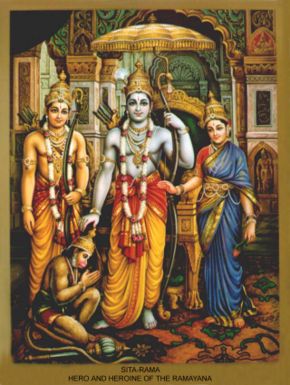
Lord Rama, Sita, Lakshman and Hanuman |
Contents

1. Implied meaning of some names in the Ramayan
1.1 According to the Bhavartha Ramayan by Saint Ekanath
- Aja: Parabrahman or Paramatma (The Absolute Being).
- Dasharath: The word Dasharath (दशरथ) is derived from two words, dash (दश) and rath (रथ). Dash means ten and rath, the body. Dasharath thus refers to the body with the five sense organs and five motor organs. Dasharath was created from Aja.
- Rama: Without loosing ajatva (absoluteness) Rama that is ahamatma (The embodied soul) was born to Dasharath.
- Kousalya: Sadvidya (The Divine intellect)
- Sumitra: Shuddha buddhi (The Pure Intellect)
- Kaikeyi: Avidya (Nescience)
- Manthara: Kuvidya (The Impure Intellect)
- Lakshman: Atmaprabodh (Awakened state of the soul)
- Bharat: Bhavartha (The implied meaning)
- Shatrughna: Nijanirdhar (His own Resolve)
- Vishvamitra: Vivek (The Intellect that differentiates between Sat and Asat)
- Vasishtha: Vichar (The Holy thinking)
- Sita: Chitshakti (The Divine Energy). The union of the Absolute Being and The Divine Energy is eternal.
1.2 As told by H.H. Anna Karandikar
A. Dasharathi Rama
- Such a body in which Rama dwells is the soul principle (atmaram).
- ‘Dasharath refers to the seeker, and the intellect in the form of Kousalya is his wife. When the seeker behaves in a manner conducive for Self-realisation, having faith and detachment generated from devotion, he is showered with Bliss. This itself is Self-realisation and the incarnation of Lord Shrirama.’
B. According to Ramottartapaniya Upanishad: Syllables of Omkar have been described in the Ramottartapaniya Upanishad as follows.
Syllables of
ॐ |
State of the mind |
Principle |
Creation of
whom? |
| A (अ) |
Waking (jagruti) |
Universe,
Vaishvanar |
Lakshman |
| U (उ) |
Dream (svapna) |
Taijas,
Hiranyagarbha |
Shatrughna |
| M (म) |
Deep sleep (sushupti) |
Pradnya, God |
Bharat |
Half
Mantra |
Superconsciousness (turya) |
Parameshvar, the
Absolute Brahman |
Shrirama |
The Upanishad further states that the Primal Energy in the form of Prakruti which causes creation, sustenance and dissolution of the universe is ‘Shri Sita’.
C. Names in the Ramayan and numerology
Rama (राम) and Sita (सीता): There are 2 letters in each of these Names.
Lakshman (लक्ष्मण) and Urmila (ऊर्मिला): There are 3 letters in each of these names.
Bharat (भरत) and Mandavi (मांडवी): In each of these names there are 3 letters.
Shatrughna (शत्रुघ्न) and Shrutkirti (श्रुतकीर्ति): There are 4 letters in each of these names.
According to numerology the number 3 is closer to number 2. Hence Lakshman and Bharat both being three letter words, were closer to Rama which is a two letter word. Since number four is not as close to number two, there is not much reference of Shatrughna in the Ramayan.
D. Lav: One who bends in whatever direction the wind blows and does not get destroyed, one who can thrive under all circumstances.
E. Kush: This is a type of grass. Just as grass thrives even on rocks he is one who survives under all circumstances.
F. The everlasting quiver: The same amount of radiance emanating from the sun principle is reflected back onto the basic sun principle (mula surya); hence the sun is eternal. Similarly the number of arrows (energy) shot by Rama returned to Him. Hence His quiver was everlasting.
G. Shabari: Shabari was conversant with Shabari vidya, a type of occult science. Under the pretext of eating berries, Rama learnt it from her and she imparted that knowledge to Him.
H. Marich: The supernatural power which enables one to transform oneself into a deer is called Maruchi. The one who posesses such a power is called Marich.
I. The ten-headed Ravan: Ravan was ten-headed that is a Brahman well versed in the knowledge of the ten scriptures (dashgranthi). Ravan was the son of Sage Pulastya. Pula is the vagina or the birth passage. This sage had made spiritual progress through the Path of Distressing Energy (Vamamarga). Once Ravan shook every channel (nadi) in his body and created a sound like that of Rudra’s vina (a stringed instrument). This appeased Lord Shiva.
J. Bibhishan: The embodied soul is situated above the navel according to one school of thought. During spiritual practice as it descends to the region of the navel (बिंब), one gets a terrifying (भीषण) experience. Hence it is called bibhishan [बिभीषण= bhishan (भीषण) + bimba (बिंब) by reversing the order of words]. Bibhishan’s spiritual level corresponding to his name was upto the level of the navel, that is the level of the Manipur chakra.
K. Lanka: Lanka means the head which lies above the neck. Rama handed over the kingdom of Lanka to Bibhishan means that He made Bibhishan progress spiritually upto the level of the Sahasrar chakra.
L. Indrajit: Indrajit had control over all His organs (jitendriya). (Jit means victory and indriya means sense organs.)
M. Bindu and Rekha: These are the consorts of Narantak one of the sons of Ravan. The embodied soul should not remain bound by attractions of Bindu and Rekha, that is any kind of attraction. Otherwise they bring about the end (ant, antak) of man (nara).
2. Implied meaning of some incidents from the Ramayan
2.1 Sita, the daughter of the Earth
Incident: Sita was found while ploughing the soil.
Implied meaning: Infant Sita was the manifest form of the hiranyagarbha frequencies emanating from the centre of the earth. Since sound, touch, form, taste, odour and energy coexist, when one of the components is present, all the others are also present. For instance, when a Name is chanted, the form, odour, etc. accompany it; so also Infant Sita was the manifest form of a specific energy that is hiranyagarbha energy, while Sita as Rama’s wife was the form of Rama’s Energy. Further information on hiranyagarbha frequencies is given in ‘Science of Spirituality – Chapter 11 – Supreme God, God, Incarnations and Deities’, point ‘Guardian deity of a territory (kshetrapaldevata)’.
2.2 Kaikeyi’s asking for a boon
Incident: With one boon Kaikeyi got Rama banished to the forest for fourteen years and with the other, she asked that Bharat be made the crown prince.
Implied meaning: Shravankumar’s grandfather was Sage Dhoumya and his parents were Ratnavali and Sage Ratna. Sage Ratna was the royal priest of the kingdom of Nandigram ruled by King Ashvapati. Kaikeyi was the daughter of King Ashvapati. Sage Ratna had taught Kaikeyi all the scriptures and had also warned her that Dasharath’s children would not be able to ascend the throne and that if they did ascend it within fourteen years after him, then the Raghu dynasty would be destroyed. To prevent this mishap, Sage Vasishtha told Kaikeyi to ask Dasharath for two boons, by one of which she sent Rama into exile for fourteen years and by the other asked Bharat to rule the kingdom because she knew that as long as Rama lived, Bharat would never ascend the throne. It is on the advice of Sage Vasishtha, that Bharat installed Rama’s paduka (wooden footwear) instead of His idol, on the throne. If instead of the paduka an idol was installed on the throne, then by the rule that sound, touch, form, taste and odour all coexist, the effect would have been just as if Rama had ascended the throne. The original Valmiki Ramayan contains three verses (shlokas) in this context. However some researchers feel that those who rewrote the Ramayan after 1228 A.D. omitted these.
2.3 Bharat’s asking for Rama’s paduka (wooden footwear)
‘Asking for the paduka’ means ‘placing the head on the feet’ or ‘complete surrender’. When Bharat asked for Rama’s paduka the latter gave them to him. The former carried them placing them on his head such that the big toes faced the front. Then he installed them on the throne and worshipped them. Since then the custom of worshipping paduka of the spiritually evolved began.
2.4 Bharat’s stay at Nandigram
A. Incident: After acquiring Rama’s paduka Bharat took them to Nandigram and installed them there. He did not reside in Ayodhya.
Implied meaning: Nandigram means the testes. So it implies that Bharat observed celibacy. ‘Installation of Rama’s paduka’ implies that Bharat lived like a seeker.
B. Incident: When accepting Rama’s paduka Bharat requested Him to inform him about His return from exile along with Sita, on the eve of His arrival, so that he could make preparations for His reception. Upon this, Rama uttered, “So be it (tathastu)”.
Implied meaning: ‘Along with Sita’ means along with Divine Energy, that is after activation of the spiritual energy (kundalini). ‘About His return’ means before attainment of Self-realisation, that is before going into the nirbij superconscious state (samadhi). Bharat said that he should know when He would go into that state.
2.5 Lakshman’s life in exile
Incident: Sita used to feel that before fetching home roots and tubers, Lakshman must have already eaten some. Rama used to feel that Sita must have served him a meal. So both of them did not bother to enquire about his meals.
Implied meaning: For fourteen years Lakshman survived only on air. He did not even sleep for the sake of Rama’s security. He practised Spirituality constantly.
2.6 Sita’s abduction
Incident: Ravan abducted Sita and kept Her with him.
Implied meaning: The real Sita never went with Ravan. She entered the fire. It was Sita’s image which accompanied Ravan. It was here that Rama’s divine sport (Ramalila) really began. After being liberated from the clutches of Ravan, on the pretext of purification in the fire, this form of Hers entered the fire again and the real Sita emerged from it.
2.7 Rama’s embracing the trees
Incident: After Sita’s abduction crying out for Sita, Rama embraced the trees.
Implied meaning: He found out how the trees and creepers felt.
2.8 Slaying of Vali
Incident: Rama shot Vali with an arrow and killed him.
Implied meaning: After the arrow struck Vali, his spiritual progress which had stopped at the level of the Anahat chakra began once again and he was liberated.
2.9 Rajak’s accusing Sita
Incident: A washerman named Rajak pronounced that Sita was unchaste. Hence Rama forsook Her.
Implied meaning 1: The one accusing Sita, Rajak is depicted as a washerman. His job is to wash clothes and cleanse them of stains. The washerman said so to prevent Rama from being stigmatised.
Implied meaning 2: The washerman’s name Rajak (रजक) is derived from two words ‘raja (रज)’ and ‘k (क)’. ‘K’ denotes a small part of an object. This means that the washerman was one who possessed some portion of the raja component in him. Hence he could not perceive the sattvik (sattva predominant) nature of Sita.
2.10 Slaying of Shambuk
Incident: Rama slayed Shambuk, a matang (one belonging to a low class) because he undertook austerities (tapashcharya).
Implied meaning: Shambuk undertook the wrong austerities. Consequently the atmosphere on the earth was polluted to such an extent that the subjects were distressed and the spiritual practice of the sages was interrupted. So to fulfill the duty of a king, in the interest of His subjects and to protect the sages Rama beheaded Shambuk.
2.11 Rama’s renouncing His body in water (jalasamadhi)
Incident: After Sita was engulfed by Mother Earth, Rama ended His life by jumping into river Sharayu.
Implied meaning: Rama did not commit suicide by jumping into river Sharayu, but took samadhi in water. There are several types of samadhis – samadhi in the earth (bhumisamadhi), in water (jalasamadhi), in the fire (agnisamadhi), etc. Saint Eknath and Saint Ramatirtha also took samadhi in water. This is possible only for those who have no attachment to the body. All the residents of Ayodhya too followed suit because, after Shrirama’s renunciation of the body they felt that their life without Rama was now meaningless.
Detailed information on the superconscious state (samadhi) is given in ‘Science of Spirituality : Chapter 36 – Path of Meditation (Dhyanyoga)’.
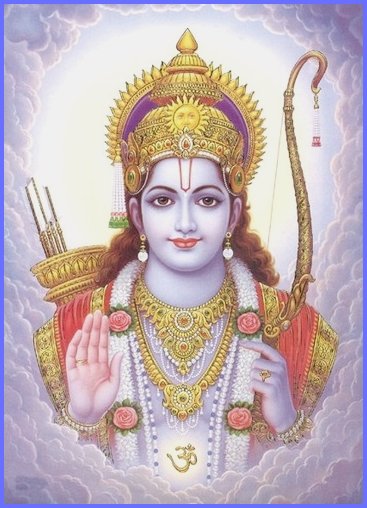




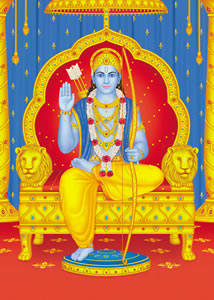


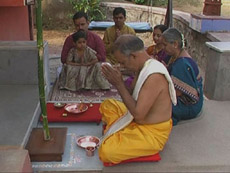 The divine consciousness emanating during sunrise, absorbed at that time lasts longer. Thus the Gudi should be worshipped within 5-10 minutes after sunrise!
The divine consciousness emanating during sunrise, absorbed at that time lasts longer. Thus the Gudi should be worshipped within 5-10 minutes after sunrise! 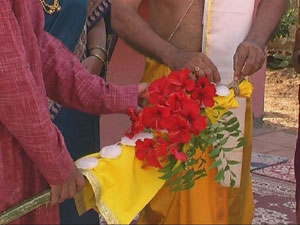 Position of the Gudi: Care should be taken to raise the Gudi next to the main entrance of the house. The spot selected should be on the right side (when sighted from the house) of the entrance. The right side symbolizes active state of the soul.
Position of the Gudi: Care should be taken to raise the Gudi next to the main entrance of the house. The spot selected should be on the right side (when sighted from the house) of the entrance. The right side symbolizes active state of the soul.  He displays emotions of happiness & unhappiness just like humans do. (His melancholy at Sita’s abduction is an example.) Hence, we feel closer to Him than we feel towards other deities.
He displays emotions of happiness & unhappiness just like humans do. (His melancholy at Sita’s abduction is an example.) Hence, we feel closer to Him than we feel towards other deities. 

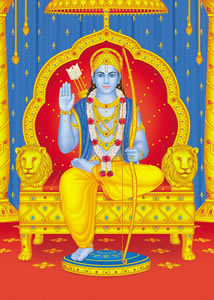
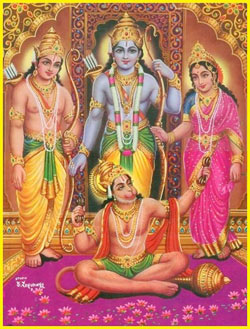 Shrirama Navami is called a holy festival (sun) when it is celebrated individually, a religious festival (utsav) when celebrated collectively and when performed individually with a resolve (sankalpa) it becomes a vowed observance (vrat). Also, unlike most vowed religious observances, which are practiced individually, Shrirama Navami is a vowed religious observance undertaken by a group.
Shrirama Navami is called a holy festival (sun) when it is celebrated individually, a religious festival (utsav) when celebrated collectively and when performed individually with a resolve (sankalpa) it becomes a vowed observance (vrat). Also, unlike most vowed religious observances, which are practiced individually, Shrirama Navami is a vowed religious observance undertaken by a group.